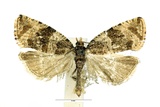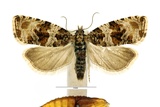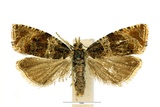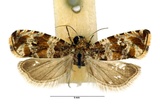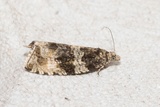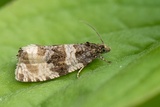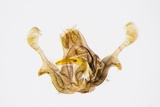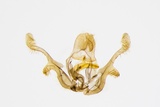Orthotaenia undulana ([Denis & Schiffermüller], 1775) Species
Last modified: Oct. 30, 2025, 8:16 p.m.
A widely distributed and fairly common species in Belgium.
Details
- Classification
- Family: Tortricidae > Subfamily: Olethreutinae > Tribus: Olethreutini > Genus: Orthotaenia > Species: Orthotaenia undulana
- Vernacular names
- Woudbladroller (NL), Woodland Marble (EN), Gewellter Waldrandwickler (DE)
- Synonyms
- Orthotaenia urticana sensu Hübner, 1799
- First mention in Belgium
- De Sélys-Longchamps E. 1844. Énumération des insectes Lépidoptères de la Belgique. — Mémoires de la Société royale des Sciences de Liége 2: 1–35. On page 21.
- Status
-
Native
Distribution
Imago
Wingspan 15–20 mm. The imago is similar to some forms of Celypha lacunana. Orthotaenia undulana shows more discrete markings. It lacks the incision on the basal edge of the central band and the central lacuna. The distal edge of the central band may have a double projection or a single broad one when these are merged.
It may also resemble Celypha cespitana and Celypha rivulana but has no strong markings in the distal third of the wing.
Caterpillar
The larva has a black head with brown mouthparts. The prothoracic plate is black or pitchy brown with a paler anterior border. The thoracic legs are dark brown or blackish. Full-grown larvae are dark reddish brown, but earlier instars may lack the reddish hue. The pinacula are coloured as the body, or a little darker. The anal plate is dark brown or black with an anal comb.
Bionomics
The larvae living between leaves spun together with silk. Pupation takes place in the larval habitation or a freshly spun leaf.
The adults are active from dusk onwards and later come to light.
Flight periods
The adults fly usually from May till August, occasionally later.
Observed on
- Host plant (species):
- Myrica gale
- Host plant (genera):
- Lonicera, Vaccinium, Betula and Pulmonaria
- Substrates:
- Deciduous trees, Shrubs, Polyphagous and Herbaceous plants
The polyphagous larva lives between spun leaves of Lonicera, Vaccinium, Myrica, Betula, and a wide range of other trees, shrubs and herbaceous plants.
Habitat
It inhabits many habitats like woods, gardens, moors, dunes, hedgerows, dry pastures etc...

